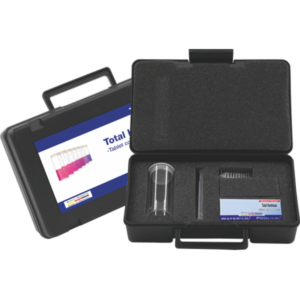Mini-kits
SVZ500*

Kit to determine the Alkalinity-M value by the tablet count method.
Some Water-i.d.® Mini Kits are based on the tablet counting method, in which tablets are added to the water until the colour changes in a defined way. The amount of tablets added is entered into a formula to determine the measured value. The innovative Water-i.d.® tablet push-through blisters simplify the procedure. In the turbidity method, the water sample becomes turbid after the reagent is added. The intensity of the turbidity determines the value. In the yes/no test method, a distinction is made between 2 different colours. Depending on which colour develops, the parameter is present in the sample or not. Both the titration and turbidity methods and the yes/no test are simple and proven measuring methods for determining water values.
| Parameter | Measuring Range |
|---|---|
| Alkalinity M | 10 – 500 mg/l (ppm) CaCO3 |
SVZ550

Kit to determine the Alkalinity-P value by the tablet count method
Some Water-i.d.® Mini Kits are based on the tablet counting method, in which tablets are added to the water until the colour changes in a defined way. The amount of tablets added is entered into a formula to determine the measured value. The innovative Water-i.d.® tablet push-through blisters simplify the procedure. In the turbidity method, the water sample becomes turbid after the reagent is added. The intensity of the turbidity determines the value. In the yes/no test method, a distinction is made between 2 different colours. Depending on which colour develops, the parameter is present in the sample or not. Both the titration and turbidity methods and the yes/no test are simple and proven measuring methods for determining water values.
| Parameter | Measuring Range |
|---|---|
| Alkalinity-P (mg/l CacO3) | 20 – 500 mg/l (ppm) CaCO3 |
SVZ555

Kit to determine the Alkalinity-P value (BaCl2) by the tablet count method.
Some Water-i.d.® Mini Kits are based on the tablet counting method, in which tablets are added to the water until the colour changes in a defined way. The amount of tablets added is entered into a formula to determine the measured value. The innovative Water-i.d.® tablet push-through blisters simplify the procedure. In the turbidity method, the water sample becomes turbid after the reagent is added. The intensity of the turbidity determines the value. In the yes/no test method, a distinction is made between 2 different colours. Depending on which colour develops, the parameter is present in the sample or not. Both the titration and turbidity methods and the yes/no test are simple and proven measuring methods for determining water values.
| Parameter | Measuring Range |
|---|---|
| Alkalinity-P (mg/l CacO3) | 20 – 500 |
SVZ1300**
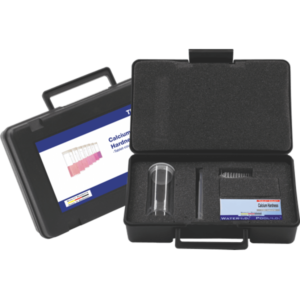
Kit to determine the Calcium Hardness value by the tablet count method.
Some Water-i.d.® Mini Kits are based on the tablet counting method, in which tablets are added to the water until the colour changes in a defined way. The amount of tablets added is entered into a formula to determine the measured value. The innovative Water-i.d.® tablet push-through blisters simplify the procedure. In the turbidity method, the water sample becomes turbid after the reagent is added. The intensity of the turbidity determines the value. In the yes/no test method, a distinction is made between 2 different colours. Depending on which colour develops, the parameter is present in the sample or not. Both the titration and turbidity methods and the yes/no test are simple and proven measuring methods for determining water values.
| Parameter | Measuring Range |
|---|---|
| Calcium Hardness | 10 – 500 mg/l (ppm) CaCO3 |
SVZ1400**
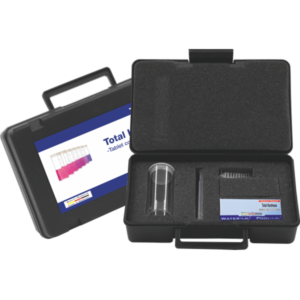
Kit to determine the Total Hardness HR value by the tablet count method.
Some Water-i.d.® Mini Kits are based on the tablet counting method, in which tablets are added to the water until the colour changes in a defined way. The amount of tablets added is entered into a formula to determine the measured value. The innovative Water-i.d.® tablet push-through blisters simplify the procedure. In the turbidity method, the water sample becomes turbid after the reagent is added. The intensity of the turbidity determines the value. In the yes/no test method, a distinction is made between 2 different colours. Depending on which colour develops, the parameter is present in the sample or not. Both the titration and turbidity methods and the yes/no test are simple and proven measuring methods for determining water values.
| Parameter | Measuring Range |
|---|---|
| Total Hardness | 10 – 500 mg/l (ppm) CaCO3 |
SVZ1450**
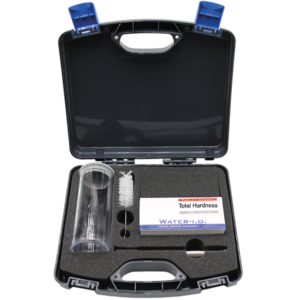
Kit to determine the Total Hardness LR value by the tablet count method.
Some Water-i.d.® Mini Kits are based on the tablet counting method, in which tablets are added to the water until the colour changes in a defined way. The amount of tablets added is entered into a formula to determine the measured value. The innovative Water-i.d.® tablet push-through blisters simplify the procedure. In the turbidity method, the water sample becomes turbid after the reagent is added. The intensity of the turbidity determines the value. In the yes/no test method, a distinction is made between 2 different colours. Depending on which colour develops, the parameter is present in the sample or not. Both the titration and turbidity methods and the yes/no test are simple and proven measuring methods for determining water values.
| Parameter | Measuring Range |
|---|---|
| Total Hardness | 1 – 50 mg/l CaCO3 |
SVJ1400
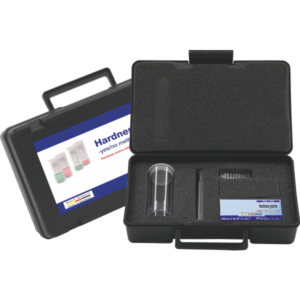
Kit to determine the Total Hardness value by the Yes/No method.
Some Water-i.d.® Mini Kits are based on the tablet counting method, in which tablets are added to the water until the colour changes in a defined way. The amount of tablets added is entered into a formula to determine the measured value. The innovative Water-i.d.® tablet push-through blisters simplify the procedure. In the turbidity method, the water sample becomes turbid after the reagent is added. The intensity of the turbidity determines the value. In the yes/no test method, a distinction is made between 2 different colours. Depending on which colour develops, the parameter is present in the sample or not. Both the titration and turbidity methods and the yes/no test are simple and proven measuring methods for determining water values.
| Parameter | Measuring Range |
|---|---|
| Total Hardness (CaCO3 mg/l) | 4 / 8 / 20 |
SVZ1600

Kit to determine the Chloride value by the tablet count method.
Some Water-i.d.® Mini Kits are based on the tablet counting method, in which tablets are added to the water until the colour changes in a defined way. The amount of tablets added is entered into a formula to determine the measured value. The innovative Water-i.d.® tablet push-through blisters simplify the procedure. In the turbidity method, the water sample becomes turbid after the reagent is added. The intensity of the turbidity determines the value. In the yes/no test method, a distinction is made between 2 different colours. Depending on which colour develops, the parameter is present in the sample or not. Both the titration and turbidity methods and the yes/no test are simple and proven measuring methods for determining water values.
| Parameter | Measuring Range |
|---|---|
| Chloride | 5 – 5000 mg/l CI |
SVT1100

Kit to determine the Cyanuric Acid value by the opacity method.
Some Water-i.d.® Mini Kits are based on the tablet counting method, in which tablets are added to the water until the colour changes in a defined way. The amount of tablets added is entered into a formula to determine the measured value. The innovative Water-i.d.® tablet push-through blisters simplify the procedure. In the turbidity method, the water sample becomes turbid after the reagent is added. The intensity of the turbidity determines the value. In the yes/no test method, a distinction is made between 2 different colours. Depending on which colour develops, the parameter is present in the sample or not. Both the titration and turbidity methods and the yes/no test are simple and proven measuring methods for determining water values.
| Parameter | Measuring Range |
|---|---|
| Cyanuric acid | 0 – 200 mg/l |
SVZ1700

Kit to determine the Nitrite value by the tablet count method.
Some Water-i.d.® Mini Kits are based on the tablet counting method, in which tablets are added to the water until the colour changes in a defined way. The amount of tablets added is entered into a formula to determine the measured value. The innovative Water-i.d.® tablet push-through blisters simplify the procedure. In the turbidity method, the water sample becomes turbid after the reagent is added. The intensity of the turbidity determines the value. In the yes/no test method, a distinction is made between 2 different colours. Depending on which colour develops, the parameter is present in the sample or not. Both the titration and turbidity methods and the yes/no test are simple and proven measuring methods for determining water values.
| Parameter | Measuring Range |
|---|---|
| Nitrite (mg/l NaNO2) | 70 – 1500 |
SVZ1800
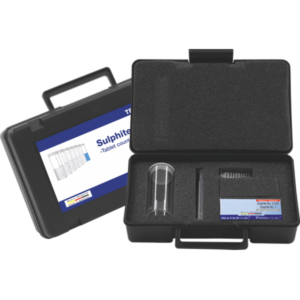
Kit to determine the Sulphite (LR) value by the tablet count method.
Some Water-i.d.® Mini Kits are based on the tablet counting method, in which tablets are added to the water until the colour changes in a defined way. The amount of tablets added is entered into a formula to determine the measured value. The innovative Water-i.d.® tablet push-through blisters simplify the procedure. In the turbidity method, the water sample becomes turbid after the reagent is added. The intensity of the turbidity determines the value. In the yes/no test method, a distinction is made between 2 different colours. Depending on which colour develops, the parameter is present in the sample or not. Both the titration and turbidity methods and the yes/no test are simple and proven measuring methods for determining water values.
| Parameter | Measuring Range |
|---|---|
| Sulphite (mg/l Na2SO3) | 2 – 50 |
SVZ1850
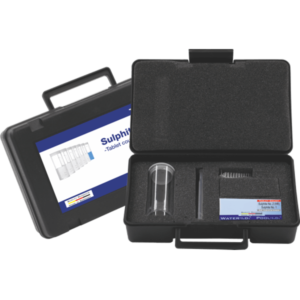
Kit to determine the Sulphite (HR) value by the tablet count method.
Some Water-i.d.® Mini Kits are based on the tablet counting method, in which tablets are added to the water until the colour changes in a defined way. The amount of tablets added is entered into a formula to determine the measured value. The innovative Water-i.d.® tablet push-through blisters simplify the procedure. In the turbidity method, the water sample becomes turbid after the reagent is added. The intensity of the turbidity determines the value. In the yes/no test method, a distinction is made between 2 different colours. Depending on which colour develops, the parameter is present in the sample or not. Both the titration and turbidity methods and the yes/no test are simple and proven measuring methods for determining water values.
| Parameter | Measuring Range |
|---|---|
| Sulphite (mg/l Na2SO3) | 10 – 500 |
SVZ2700
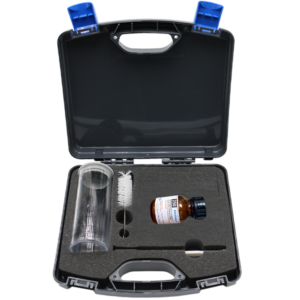
Kit to determine the Cleaning Acid Strength (CAS) concentration
Some Water-i.d.® Mini Kits are based on the tablet counting method, in which tablets are added to the water until the colour changes in a defined way. The amount of tablets added is entered into a formula to determine the measured value. The innovative Water-i.d.® tablet push-through blisters simplify the procedure. In the turbidity method, the water sample becomes turbid after the reagent is added. The intensity of the turbidity determines the value. In the yes/no test method, a distinction is made between 2 different colours. Depending on which colour develops, the parameter is present in the sample or not. Both the titration and turbidity methods and the yes/no test are simple and proven measuring methods for determining water values.
| Parameter | Measuring Range |
|---|---|
| CAS | 0.75 – 10.00 % |
SVS2800
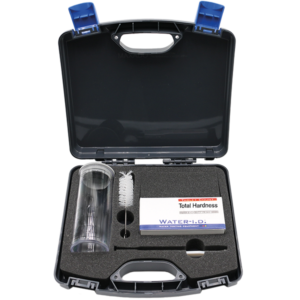
Kit to determine the Permanganate Value as well as Sewage/Effluent BOD/COD/TOC. Includes 3 x 100 shaker-/dilution tube!
Some Water-i.d.® Mini Kits are based on the tablet counting method, in which tablets are added to the water until the colour changes in a defined way. The amount of tablets added is entered into a formula to determine the measured value. The innovative Water-i.d.® tablet push-through blisters simplify the procedure. In the turbidity method, the water sample becomes turbid after the reagent is added. The intensity of the turbidity determines the value. In the yes/no test method, a distinction is made between 2 different colours. Depending on which colour develops, the parameter is present in the sample or not. Both the titration and turbidity methods and the yes/no test are simple and proven measuring methods for determining water values.
| Parameter | Measuring Range |
|---|---|
| BOD Effluent | 0 – 45 |
| BOD Sewage | 0 – 150 |
| COD Effluent | 0 – 210 |
| COD Sewage | 0 – 300 |
| TOC Effluent | 0 – 60 |
| TOC Sewage | 0 – 90 |
SVZ3700
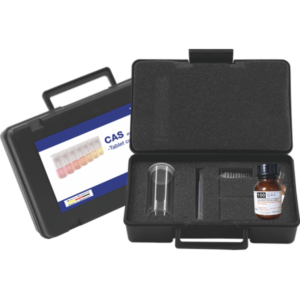
Kit to determine the Phosphonate value by drop titration method.
Some Water-i.d.® Mini Kits are based on the tablet counting method, in which tablets are added to the water until the colour changes in a defined way. The amount of tablets added is entered into a formula to determine the measured value. The innovative Water-i.d.® tablet push-through blisters simplify the procedure. In the turbidity method, the water sample becomes turbid after the reagent is added. The intensity of the turbidity determines the value. In the yes/no test method, a distinction is made between 2 different colours. Depending on which colour develops, the parameter is present in the sample or not. Both the titration and turbidity methods and the yes/no test are simple and proven measuring methods for determining water values.
| Parameter | Measuring Range |
|---|---|
| Phosphonate | 0 – 20 mg/l |
SVT4000

Kit to determine Turbidity and Suspended Solids
Some Water-i.d.® Mini Kits are based on the tablet counting method, in which tablets are added to the water until the colour changes in a defined way. The amount of tablets added is entered into a formula to determine the measured value. The innovative Water-i.d.® tablet push-through blisters simplify the procedure. In the turbidity method, the water sample becomes turbid after the reagent is added. The intensity of the turbidity determines the value. In the yes/no test method, a distinction is made between 2 different colours. Depending on which colour develops, the parameter is present in the sample or not. Both the titration and turbidity methods and the yes/no test are simple and proven measuring methods for determining water values.
